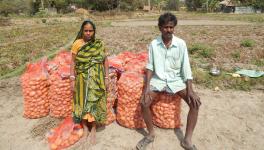Stock Holding Limits in Jute Industry ‘Anti-Farmer’, Says Jute Body
Kolkata, Sept 5: The jute industry in West Bengal, the source of livelihood for nearly 40 lakh jute growers and 2.5 lakh mill workers, is back to normal after having been affected by COVID-19 and the lockdown, like most other industries. Harvesting of raw jute is on in full swing and mill operations have stabilised.
There are indications of sufficient orders for B. Twill jute bags on the government account for packaging Kharif foodgrain. It is because output is expected to be higher than the last Kharif season due to higher acreage and satisfactory spatial and temporal distribution of monsoon. The last Rabi crop size was more than adequate too, necessitating a steady supply of jute bags for packaging by the government.
COVID-19 and the resultant prolonged lockdown announced on March 24 interfered with the supply schedule of the jute mills, which were allowed to resume production with full strength only from June 1. As a result, there has been a sizeable backlog in the supply of jute bags on the government account.
Even as mill’s operations have been gradually normalising and the Jute Commissioner (JC) has been emphasising on the steady supply of B. Twill bags against the backlog, speculation that the size of the new raw jute crop is lower than estimates made before and after sowing, have led the JC to issue regulatory orders on August 25 under the relevant clauses of the Jute and Jute Textiles Control Order, 2016.
Under Clause 6 (1) (iii) of the order, all traders, dealers, agencies and stockists of raw jute have been directed that at no point in time will they hold more than 1,500 quintals of raw jute on their own account or on the account of third parties. Raw jute stocked in a single premise, even if under different names, will be considered as total single stock. Failure to comply with the order shall attract penal action under Clause 11 of the 2016 order read with Section 7 of the Essential Commodities Act, 1955, which provides for imprisonment and fine.
The order for jute mills, also issued on August 25, is under Clause 5 (ii) of the 2016 order. It specifies that a mill – in case it has built up stocks in its premises and in upcountry godowns, including stocks in pipeline, in excess of its two months’ consumption requirement – has to reduce such stocks to two months’ consumption level in course of normal process of manufacture. The mill is also required to suspend fresh purchases of raw jute from all sources, either directly or through agents or third parties. until its stocks come down to two months’ worth of consumption.
The order shall not apply to delivery by the Jute Corporation of India, or in the case of raw jute of specified qualities required to meet jute goods export commitments and imported or to be imported jute. Import details have to be furnished to the JC. Failure to comply with the stock-holding limits will attract punishment under Clause 11 of the 2016 order read with Section 7 of the Essential Commodities Act, 1955, stipulates provides for imprisonment and fine.
That the supply of jute bags on the government’s account, in view of the higher levels of requirement, were a matter of concern for New Delhi was evident from the Centre’s repeated suggestions to the West Bengal government to take a somewhat lenient view of the lockdown restrictions and allow resumption of operations by at least some of the 20 jute mills, initially.
In an order issued on July 20, the JC asked mills to utilise the entire installed sacking capacity for “exclusive” manufacture of specified quantities of B. Twill jute bags measuring 94 cm x 57 cm. It was as per directions contained in production control-cum-supply orders (PCSOs) issued from time to time for the Kharif season, and fresh directions to be issued in due course and that no part of the aforesaid capacity shall be diverted for production of sacking other than B. Twill jute bags.
The July 20 order stated that state government agencies had estimated their B. Twill bag requirement at around 20.9 lakh bales (lb). If jute mills are found to be unable to meet requirements on the government’s account, dilution of the Jute Packaging Materials (Compulsory Use in Packing Commodities) Act, 1987 (JPM Act) and use of HDPE/PP bags (synthetic) would be recommended. Currently, under the JPM Act, 100% of foodgrains and 20% of sugar is to be packed in jute bags.
The total requirement of jute bags for Kharif marketing season (KMS) 2020-21 has been estimated – after a fifth revision – at 22 lb plus by the department of food and public distribution (DF&PD) of the Union Ministry of Consumer Affairs, Food and Public Distribution. This is seen from its letter on August 24, issued to all offices concerned. HDPE/PP bag requirement for KMS has been estimated at over 1.83 lbs. The requirement of jute bags for foodgrain packaging undergoes several revisions as state procurement agencies fine tune their estimates.
The requirement of jute bags for the Rabi marketing season (RMS) was estimated higher by the DF&PD – at 23.12 lbs for 2019-20 as against 19.27 lbs for 2018-19. For RMS 2020-21, official notes prepared for the 28th meeting of standing advisory committee under the JPM Act, 1987, mentioned the same figure of 23.12 lbs after a seventh revision.
Apprehensions of a smaller than expected crop, due to heavy rains in the jute growing areas, resulted in a price spurt from early August. Fear of a low carry-over stock prompted the regulatory clamping of stock-holding limits by the JC on August 25.
Price trends (Rs / per quintal) for the representative TD 5 (tossa desi) grade raw jute are available from quotations released by The Jute Balers’ Association:
September 4: 5,500; September 3: 5,450; September 2: 5,400; August 26: 5,350; July 24: 4,650; March 23: 4,825; and September 27, 2019: 4,575.
Accepting the recommendation of the Commission for Agricultural Costs and Prices, the Directorate of Economics and Statistics (commercial crops division) of the Union Ministry of Agriculture and Farmers Welfare, notified on April 15 the minimum support price for raw jute (TDN3 equivalent to TD 5) at Rs 4,225 per quintal for the 2020-21 jute season. This is seven per cent higher than the Rs 3,950 allowed for the 2019-20 season.
The Indian Jute Mills Association, in its recent communications to the Centre and state authorities, has made the following points:
It is becoming un-remunerative to manufacture jute goods, given the high prices of raw jute.
Mills should be allowed to import matching grade of raw jute from Bangladesh as prices there are lower than in India.
The crop size this season is likely to be 58 lbs against an estimated 67 lbs in the year before, with much higher estimates previously.
With a carry-over of 18 lb and given the import of three lbs for permissible purposes, the total availability is likely to be 79 lbs.
With the mills’ consumption of 65 lbs, the total estimated consumption of 75 lbs will leave a very low closing stock of four lbs, which it says is not a safe level.
Between early June and November-end, mills had committed to jute bag deliveries of a maximum of 13.8 lbs, taking into account optimum capacity utilisation levels.
Therefore, it found the order for 9.84 lbs of jute bags for delivery between June 9 and August 11 rather on the higher side, and beyond the capacity of the mills.
Moreover, while granting an extension for delayed deliveries, the JC had earlier stipulated that “the shortfall quantity would have to be supplied at the lowest of the price for the period starting from the month of placement of orders and up to the month of supply”. This acts as a deterrent and therefore, should not be imposed.
At the moment, the high price of raw jute is the only major issue for mills. The mills have otherwise been able to overcome the adverse effects on production caused by COVID-19. Workers who had managed to go back to their native places during the lockdown have returned, former IJMA chairman Sanjay Kajaria told NewsClick. As for the crop size, Kajaria said that he would like to hope that there is no further decline, although there are apprehensions at the moment.
Former chairman of JBA, Nirmal Bhutoria, is not sure whether the output will be at least 55 lakh bales in the end. About the high ruling prices, Bhutoria told NewsClick that as arrival of the new crop gathers momentum in the coming days, a softening trend is bound to set in before long.
As regards the IJMA’s import plea, experts point out that the textiles ministry, in its order of December 20, 2019, clearly mentioned that domestic manufacture of jute packaging materials “has to be from domestic raw jute production”.
Significantly, the regulatory stock-holding limits set by the JC are against the interests of raw jute farmers, the JBA has pointed out in a communication to the Prime Minister’s Office and the textiles ministry. JBA secretary Abhijit Palit has contended in the letter that farmers’ getting higher prices acts as an incentive for them to continue jute cultivation. Moreover, given the dearer inputs, the net realisation is not as high as the ruling prices might suggest. Further, submerged plants in low lying areas, which constitute almost 50% of West Bengal’s total jute acreage, failed to attain standard heights and farmers have had to harvest the crop at shorter lengths. As a result, yields fell.
Get the latest reports & analysis with people's perspective on Protests, movements & deep analytical videos, discussions of the current affairs in your Telegram app. Subscribe to NewsClick's Telegram channel & get Real-Time updates on stories, as they get published on our website.
























